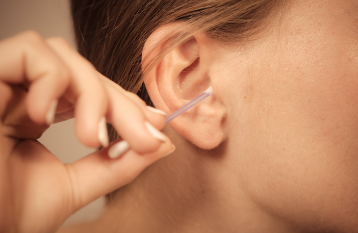Ear Anatomy
The ear can be divided into three main parts: the outer ear, the middle ear and the inner ear. Each section is comprised of number of structures which are listed below.
Outer ear: Pinna and Ear Canal
Middle ear: Ear drum and Ossicles (malleus, incus and stapes)
Inner ear: Cochlea (hearing organ), Vestibular system (for balance) and the 8th cranial nerve (hearing nerve)
How We Hear
- Sound waves are collected by the pinna and channelled through the ear canal until it reaches the ear drum.
- The ear drum then vibrates, causing a continuous chain of small bones called ossicles to move and act as an amplifier.
- The stapes – the smallest and final ossicle in the chain then exerts a force onto an area of the cochlea, causing fluid inside to ripple and bend thousands of tiny hair like cells. At this point, the kinetic energy of the fluid wave is converted into an electrical signal.
- These hair cells then produce a nerve impulse, which is transmitted by the auditory (hearing) nerve, and sent to the brain.
- When the brain receives this signal, we perceive a sound.
There are 3 main categories of hearing loss:
- Conductive Hearing Loss – caused by a problem in the hearing pathway in the outer or middle ear, causing poor transmission of sound to the cochlea.
- Sensorineural Hearing Loss – caused by nerve damage in the cochlea or along the auditory nerve.
- Mixed Hearing Loss – a combination of conductive and sensorineural elements.
What Are The Main Hearing Loss Treatments?
Conductive hearing loss
Individuals who are born with abnormal or absent outer ear. This means that the sounds are unable to travel through the ear canal effectively to strike the ear drum.
This can act like a plug inside of the ear, which blocks sounds from reaching the ear drum. A common cause of waxbuild up is through use of cotton buds. This obstruction will need to be removed by an audiologist or an ENT specialist.
A common condition among children, but can also present in adulthood. Normally, the middle ear is an air-filled space. The Eustachian tube is a structure which is responsible for making sure that the air pressure behind the ear drum is equal to in-front of the ear drum. Its other function is to drain out any normal mucus produced in the middle ear. In the instance of glue ear, mucus is unable to leave via the Eustachian tube and therefore accumulates until the ear drum eventually ruptures, allowing the fluid to escape. Treatment may include surgery (grommets) or hearing aids.
A hole in the ear drum causes poor movement of the membrane so the vibration cannot be effectively transmitted through to the ossicles. This may be as a result of recurrent ear infections, trauma or a rapid change in pressure.
Otosclerosis is when the stapes becomes fixated due to bone overgrowth at the base of the stapes. This means that the transmission of sound waves from the stapes to the cochlea is impeded. Some forms of treatment may include hearing aids or surgery. Ossicular chain separation can be caused by head trauma, penetrating trauma such as cotton buds perforating the ear drum and through the ossicles or chronic ear infections causing the ossicles to be dissolved.
When the ear drum has been weakened, this can cause abnormal accumulation of skin cells to form a ‘retraction pocket’. As this grows, it can invade the middle ear and mastoid (the bony portion behind your pinna) and erode the nearby structures including the ossicles. Symptoms may include gradual loss of hearing and smelly discharge from the affected ear.
Sensorineural hearing loss
Genetic hearing loss may present at birth, or become apparent later in life. This may be as a result of an autosomal dominant gene (inherited by one or both parents), autosomal recessive (the defective gene is passed down by both parents before ithearing loss is presented in the child) or X-linked recessive (defective gene passed on by the mother via the sex chromosome). It is not uncommon for a child with hearing loss to be born to normal hearing parents.
Some medications and treatments can cause temporary or permanent hearing loss and/or balance problems. Examples include aspirin, quinine, aminoglycoside antibiotics, loop diuretics, cisplatin and carboplatin. If you are taking any of these medications, it is important to seek advice from your general practitioner first before making any changes.
A sudden loss in hearing, this may be in one ear or both ears. This is considered to be a medical emergency. If you have experienced a sudden hearing loss. Please visit accident and emergency immediately to allow the best chance of recovering your hearing.
General wear and tear of the hair cells within the cochlea over a number of years. This is usually characterised with poor hearing in the higher pitches, and better hearing in the lower pitches.
After exposure to loud noise such as a busy pub, you may have experienced temporary hearing loss and tinnitus. Following the incident, your hearing may gradually return and the tinnitus resolves. However, after repeatedexposurethe hearing loss and tinnitusis likely to become more permanent. This is highly dependent on the intensity and duration of exposure, as well as individual susceptibility.

Guide to earwax build-up
The build-up of ear wax is a common problem and while it's uncomfortable and annoying, the good news is that it can be treated. There are a number of ways to remove a build-up of ear wax, which is why we’ve created this extensive guide…
Read More
Otitis Externa (Swimmers Ear)
Otitis externa, also known as swimmer's ear, is a condition that occurs when the ear canal becomes inflamed due to infection or irritation. It is a common condition that can cause symptoms such as ear pain, itching, and discharge. Causes: Otitis externa is typically caused…
Read More
Middle Ear Infection
A middle ear infection, also known as otitis media, is a common condition that occurs when the middle ear becomes inflamed due to a bacterial or viral infection. It is a common condition that affects both children and adults and can cause symptoms such as…
Read More